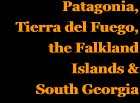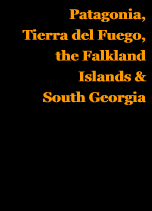|
Appendix 3
60cm gauge steam locos of the Chilean state-run railways
The Chiloé railway's locomotive stock is still somewhat unclear, not least because as part of the state railways locos could be swapped from line to line. Add to that the practice of opening new lines under the auspices of the Dirección General de Obras Publicas using their own locos and sometimes others bought from the contractor who built the railway, and there is a recipe for considerable confusion. In fact the only way to study the developing situation is to examine the DOP's and FCE's national stock of 60cm gauge locos. It is worth noting at this point that the FCE south-central network operated four 60 cm. gauge branches. As well as the Ancud-Castro line there were the branches to Capitan Pastene, Recinto and Colbun further north. Tables of data published in the past give overall figures such as totals of 17 locos, 26 coaches, 6 furgons, and 120 wagons, but these are never broken down into separate totals for each line (5). In addition, the army operated a further line, from Puente Alto outside Santiago to El Volcan, as a long-term training exercise. This had been built along with the FCE lines and had received stock and locos from the same sources before going its own way in later years.
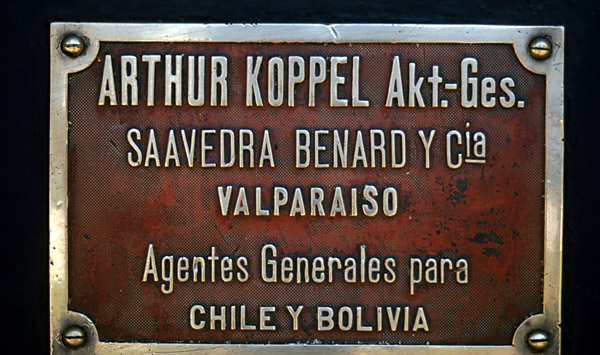
The agents' plate carried by one of the batch of Jung 0-6-2Ts which eventually became the FCE's class 'a'. This particular loco was allocated to the construction of the Puente Alto to Volcan line near Santiago, which meant that it survived long enough to be preserved.
The first substantial source of information about narrow gauge locos comes in the tables published in reports ('Memorias') by the DOP in 1910 and 1914, and available in the Archivo Nacional in Santiago., They have been re-organised here by wheel arrangement/number. Note that locos were known to the DOP by name; subsequent running numbers were sometimes duplicated as individual locations allocated their own numbers.
Dirección General do Obras Publicas - 60cm gauge locos on the books in 1910 and 1914.
|
Wheel arrange-ment
|
Name
|
Running number
|
Builder
|
Location in 1910
|
Location in 1914
|
Weight in tonnes
|
Nominal HP
|
Notes added for this website
|
0-4-0T
|
 |
 |
O&K
|
 |
Iquique water works
|
8.0
|
73
|
Possibly
one and
the same
loco.
|
0-4-0T
|
 |
 |
O&K
|
Puente Alto
|
 |
7.6
|
73
|
0-4-0T
|
 |
 |
Henschel
|
Chiloe
|
Chiloe
|
8.6
|
90
|
Later class 'g'.
|
0-4-0T
|
Pedro Garcia de la Huerta
|
 |
Hanomag?
|
Chillan
|
 |
8.7
|
90
|
 |
0-4-0T
|
Centenario
|
 |
Hanomag?
|
Saboya
|
 |
8.7
|
90
|
 |
0-4-0T
|
Lumaco
|
3
|
Hanomag?
5376?
|
 |
Saboya
|
8.7
|
90
|
In 1918 still at Saboya and numbered 44.
|
0-4-0T
|
O'Higgins
|
3
|
Hanomag?
5377?
|
 |
Chillan
|
8.7
|
90
|
 |
0-4-0T
|
Fresia
|
24
|
Jung 1859-62
|
---
|
Linares
|
9.3
|
90
|
Later class'c'.
|
0-4-0T
|
Guacolda
|
25
|
Jung 1859-62
|
---
|
Linares
|
9.3
|
90
|
Later class'c'.
|
0-4-0T
|
Tegualda
|
26
|
Jung 1859-62
|
---
|
Saboya
|
9.3
|
90
|
Later class'c'.
|
0-4-0T
|
Glaura
|
27
|
Jung 1859-62
|
---
|
Saboya
|
9.3
|
90
|
Later class'c'.
|
0-6-0T
|
 |
 |
O&K 3992?
|
Owned by contractor, on Chiloé
|
Chiloé
|
7.0
|
70
|
Possibly later class 'f'.
|
0-6-0T
|
 |
 |
O&K
|
Owned by contractor, on Chiloé
|
Chiloé
|
9.0
|
90
|
O&K no. 5815? Possibly later class 'e'.
|
0-6-0T
|
Colbun
|
 |
Henschel
|
Puente Alto
|
 |
15.5
|
144
|
 |
0-6-0T
|
Trabajadora
|
1
|
Henschel
|
Saboya
|
Saboya
|
15.5
|
144
|
One of Henschel 9851-3. 1918 had moved to Linares and was numbered 43. Later class 'b'.
|
0-6-0T
|
Saboya
|
2
|
Henschel
|
Saboya
|
Saboya
|
15.5
|
144
|
One of Henschel 9851-3. Later class 'b'.
|
0-6-0T
|
Colbun
|
(3?)
|
Henschel
|
Puente Alto
|
Puente Alto
|
15.5
|
144
|
One of Henschel 9851-3. Illustrated in Henschel 1910 catalogue.
|
0-6-0T
|
Enrique Döll
|
17
|
Jung
|
 |
Linares
|
15.5
|
144
|
One of Jung 1852-8. Later class 'b'.
|
0-6-0T
|
Victor Klein
|
18
|
Jung
|
 |
Chillan
|
15.5
|
144
|
One of Jung 1852-8. Later class 'b'.
|
0-6-0T
|
Alessandre Bertrande
|
19
|
Jung
|
 |
Received at Chillán in April 1913
|
15.5
|
144
|
One of Jung 1852-8. Later class 'b'.
|
0-6-0T
|
Matilde, renamed Acevedo in April 1913.
|
20
|
Jung
|
 |
Received at Chillán in April 1913
|
15.5
|
144
|
One of Jung 1852-8. Later class 'b'.
|
0-6-0T
|
Maria Luisa
|
21
|
Jung
|
 |
Saboya
|
15.5
|
144
|
One of Jung 1852-8. Later class 'b'.
|
0-6-0T
|
Vitalia
|
22
|
Jung
|
 |
Saboya
|
15.5
|
144
|
One of Jung 1852-8. 1918 still at Saboya and numbered 45. Later class 'b'.
|
0-6-0T
|
 |
23
|
Jung
|
 |
 |
15.5
|
144
|
One of Jung 1852-8. Later class 'b'.
|
0-6-2T
|
Presidente Montt*
|
1
|
 |
Puente Alto
|
 |
22.0
|
214
|
Sister locos later became EFE class 'a'. This is probably 'Panchita' which survived and is now at Melocotón.
|
0-6-2T
|
Alberto Mackenna
|
2
|
 |
Puente Alto
|
 |
22.0
|
214
|
Sister locos later became EFE class 'a'. This one may have been scrapped fairly early on, as there are no photos of it at Puente Alto.
|
0-6-2T
|
Pedro Montt*
|
1
|
 |
Chillan
|
To FCE but location unknown
|
22.0
|
214
|
Later class 'a'.
|
0-6-2T
|
Vicente Méndez U
|
2
|
 |
|Chillan
|
To FCE but location unknown
|
22.0
|
22.0
|
Later class 'a'.
|
0-6-2T
|
 |
 |
Jung
|
 |
To FCE but location unknown
|
22.0
|
214
|
Later class 'a'.
|
0-6-2T
|
 |
Contractor's no. 7
|
Davenport
|
Owned by contractor, on Chiloé
|
Chiloé
|
20.0
|
160
|
Later class 'd'.
|
0-6-2T
|
 |
Contractor's no. 6 or 8?
|
Davenport
|
Owned by contractor, on Chiloé
|
Chiloé
|
20.0
|
160
|
Later class 'd'.
|
 |
 |
 |
 |
 |
 |
 |
 |
 |
 |
 |
 |
 |
 |
 |
 |
 |
 |
 |
 |
 |
 |
 |
 |
 |
 |
 |
 |
 |
 |
 |
 |
 |
 |
 |
 |
* Might be same loco, but note that they are recorded at different locations in 1910.
Five locos were acquired by DOP from 'Hannover Linden', ie Hanomag, in 1909.
Chillan had five locos at end of 1913, including two of 15.5 tonnes.
Linares to Colbun also had a 6 tonne O&K, presumably an 0-4-0T, at end of 1913.
|
Other sources give a few more clues, though matching the DOP names to builders and their numbers is still difficult.
The first locos for Chiloé
It has been suggested that the original Chiloé stock was to be five locomotives large and small (1). Boldrini quotes contemporary newspaper sources which reported in 1911 that two locomotives were initially to be delivered - a small one for Ancud, and a large one for Castro. Unfortunately the lighter carrying the loco for Castro was driven ashore and it spent two months awaiting salvage (2). Later, when the construction gangs from the two ends of the line were to meet up, on 8 September 1911, the newspaper reports refer to the locomotive 'Coquiao' from Ancud, and 'Chonchina' from Castro. None of these reports give us clear details of the locomotive type or manufacturer. However, the fact that the locos were named does accord with the policy of the Dirección de Obras Públicas who supervised the construction.
A little more information can be gleaned from the locomotive builders' list (3). Three Orenstein & Koppel locos appear to have been delivered to the Ancud - Castro line via the agents Saavedra Benard y Cia. in Valparaiso. In 1910 a 40hp 0-6-0T no. 3992 presumably for construction trains; in 1912 a much bigger 90hp 0-6-0T no. 5815; and finally in 1914 a 125hp loco no. 7120. There may have been others. A look at the list of locos built by Jung during 1912 shows a total of seven 0-6-0Ts and four 0-4-0Ts produced for 60cm gauge lines of the Chilean State Railways. The 0-6-0Ts were builders' nos. 1852-8 and the 0-4-0Ts were nos. 1859-62. A full list of 60cm gauge locos produced for Chile is further down this page.
Narrow gauge locomotive classes
The next available information comes from 1920 when the FCE's annual 'Memoria' report on its activities includes the following table and notes: It is unfortunate that there are no loco names or numbers attached to each of the classes, but again we can make some educated guesses.
Type
|
Wheel arrange-ment
|
Builder
|
Gross weight
|
Weight on driving wheels
|
Driving wheel diameter
|
Cylinder diam. x stroke
|
??
|
??
|
No. of locos
|
Notes added for this website
|
a
|
1-C
|
Jung
|
22.5
|
18
|
700
|
300 x 350
|
47
|
0.72
|
3
|
 |
b
|
C
|
Jung
|
15.5
|
15.5
|
630
|
235 x 300
|
24
|
0.50
|
4
|
This class included two Henschel locos as well as Jung 1852-8.
|
c
|
B
|
Jung
|
9.3
|
9.3
|
580
|
210 x 300
|
18
|
0.40
|
2
|
From Jung 1859-62.
|
d
|
1-C
|
Davenport
|
17.5
|
14.5
|
710
|
227 x 330
|
 |
 |
2
|
Davenport 894-5, of 1909, delivered to Lezaeta, Duran y Hermanos for Ancud-Castro contract and then transferred to FCE fleet. Delivered with running numbers 7 & ?.
|
e
|
C
|
Koppel
|
8
|
8
|
550
|
185 x 265
|
 |
 |
1
|
Probably O&K 5815 of 1912.
|
f
|
1-B
|
Koppel
|
6
|
5
|
490
|
150 x 230
|
 |
 |
1
|
Probably O&K 3992 of 1910, but this should be an 0-6-0T.
|
g
|
B
|
Henschel
|
8.6
|
8.6
|
540
|
160 x 240
|
 |
 |
1
|
Possibly Henschel 7493 of 1906.
|
h
|
1-C
|
Koppel
|
19.6
|
16
|
700
|
275 x 310
|
 |
 |
1
|
Probably O&K 7120 of 1914.
|
Notas: No están incluídas las Locomotoras en desarme í desarmadas en el cuadro de dotados. No están incluídas las Locomotoras Nos. 4, 70, 76, 79, 124, 263 i 276 que se encuentran en poder de la D. O. P. Están incluídas las Locomotoras Nos. 644 i 645 que pertenecen a la D. O. P.
|
 |
Data is from FC del Estado 'Memoria' report 1920. Note wheel arrangements (in German style notation) are back to front in the case of classes A, D and H, which should be C-1 for an 0-6-2T. The class identification letters were given in the original table using upper-case letters, though all other FCE references to the NG classes use lower-case. DOP means Dirección de Obras Publicas. Of these 15 locos, four were on Chiloe at the time.
|
|
Diagram book sketches and data sheets
Basic data sheets are available for classes 'a', 'b' and 'c', can be viewed in an appendix page.
Renumbering
In the late 1920s the FCE seem to have got fed up with the ad-hoc identification of the narrow gauge locos. By 1929 or possibly at the time of the 1915 broad and metre gauge renumbering every loco was renumbered into a generic 5000 series covering all 60cm gauge machines. A table further down the page attempts to identify each engine, though a large number of early locos do not yet appear in it.
Class 'a' 0-6-2Ts
The FCE's main class of 60cm engine appears to have been a series of 0-6-2Ts, built by Arnold Jung. These appear in a number of photos.
Detailled original dimensions included a total weight of 22.8 tonnes; driving wheels of 700mm diameter; a coal capacity of 1006 kgs; and an overall length of 8.9 m. An FCE data sheet from 1939 shown in Carlos Mendez Notari's booklet (6) lists six of these engines (Nos. 5025, 38, 39, 58, 59 and 60), though again it is not clear which locos were on which line..
The grouping of these locos into a single class 'a', hides the fact that there seem to have been two or possibly three clear variants right from the start. Two photos elsewhere in this chapter show a loco of the Chiloe railway on its side after an accident. A loco of this precise pattern survives in Chile on the erstwhile FC Militar del Cajón del Maipo, better known as the FC Puente Alto-Volcan on the outskirts of Santiago.
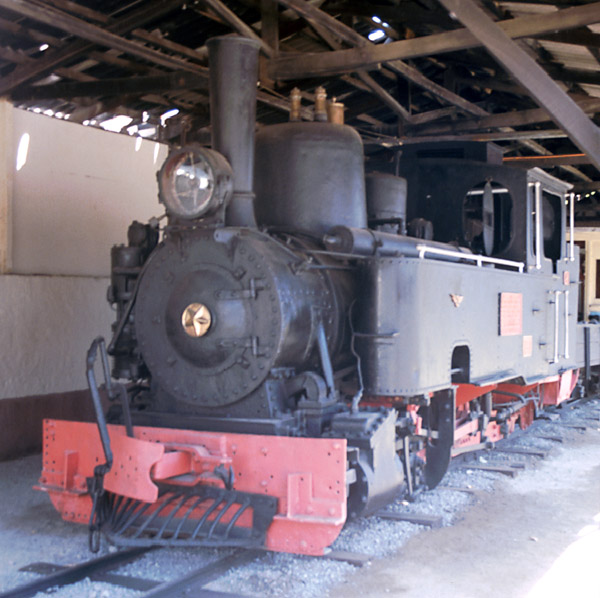
The photo above shows the Puente Alto-Volcan loco, familarly known as 'Panchita', as it was displayed in the barracks at Puente Alto for many years. More recently it has been moved to Melocotón nearby.
Ian Thompson's recent paper on the history of the military railway gives no clues as to the origin of the Puente Alto loco (15). It was clearly not one of the line's six O&K 0-8-0Ts and Señor Thompson speculates that it was most likely to have been transferred from the FCE stock at some point. More recent discoveries in the DOP memoria preserved in the Archivo Nacional suggest that it was in fact handed over to the army by the DOP on completion of the line. Whilst it bears a Koppel agency plate (see photo at head of page) Martin Murray's preserved Orenstein & Koppel loco list (7) suggests that this is actually an Arnold Jung product, no. 1306 of 1909.
Whilst it was originally thought that differences in detail visible in many photos of locos on the Chiloe railway were the result of later modifications, I am increasingly coming to the conclusion that the majority of the 'a' class locos were delivered looking very different from those just described. The majority of photos illustrating 'a' class locos show flat fronted and rather higher side tanks, larger smokebox doors, a different shape of smokebox side, and double coal rails above the tanks. The characteristic cut out and S-curve in the foot of the tank distinguish all of these locos from the class 'b' with its angular step in the running plate height at the front of the cab.
An extra variation made obvious in the FCE diagram book was that locos 5058-5060, apparently built by Jung, had a longer wheelbase than the other class 'a' engines.
It may be that those supplied by Jung differed from those built by Orenstein and Koppel despite nominally being members of the same class. Furthermore, later modifications by the FCE workshops seem to have increased the size of tanks and bunkers so the extent that the locos latterly looked very different .
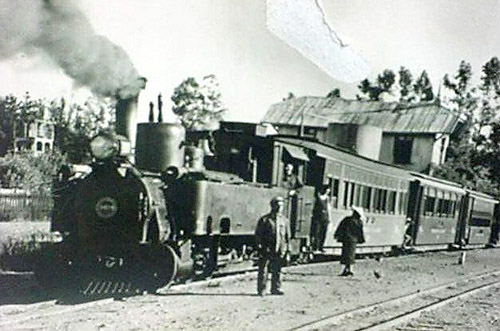
Above is one of the earlier locos with the rounded front to the tanks, whilst below is loco 5060 from the Jung 1929 built batch. The square fronted tanks are clearly visible in this shot at Recinto variously described as from 1937 or 1940.
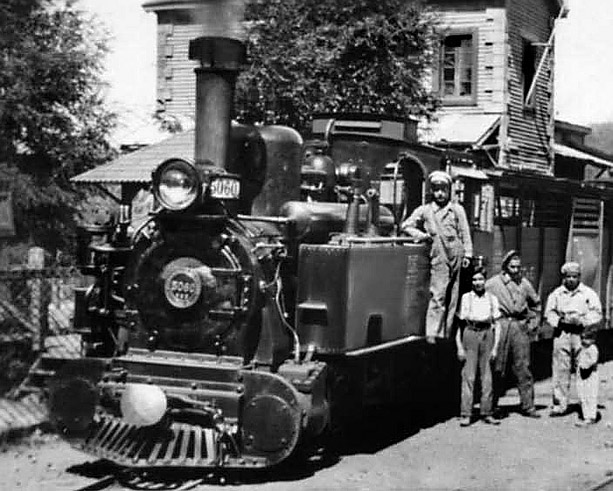
The third major variant is probably the result of a number of modifications through the locos' working lives. The tanks and bunker have gradually increased in size, but the tank cutout over the valve gear and the curved step in the running board line remain.
Class 'a' loco no. 5039. The origin and date of this photo are unknown, but thanks are due to Señor Raúl Moroni who scanned it and sent it. If on Chiloé the photo was probably taken at Ancud or Castro. More interesting are the high side tanks and the big rear bunker, which may have been later modifications.
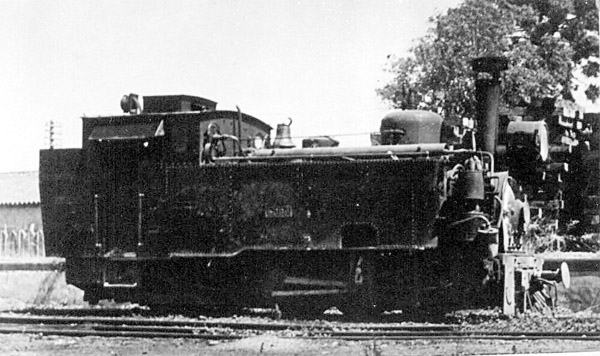
One of the last members of the class to have been in operation seems to have survived, and was to have been cosmetically restored for display in the centre of the town of Capitan Pastene northwest of Temuco. However, it was stored in Concepción at the time opf the big earthquake in 2010, and it is not yet clear whether it still exists. It may well be loco no. 5025, though its smokebox number-plate has got transferred to another smaller 60cm gauge loco now in the Quinta Normal railway museum in Santiago. This has led to much confusion.
The following two pictures were taken in 2006 and are displayed on a Flickr page linked from the Capitan Pastene town website. They show a highly modified - and rather battered - class 'a' loco. In particular note the enlarged welded tanks and bunker, and the consequent need for modifications to the cab.
.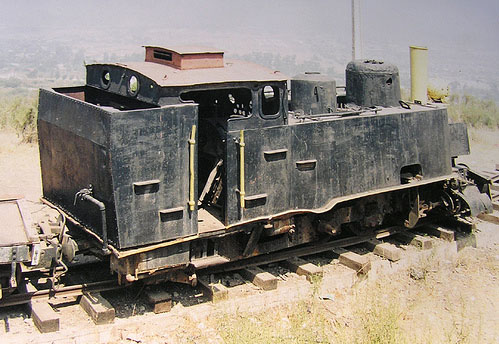
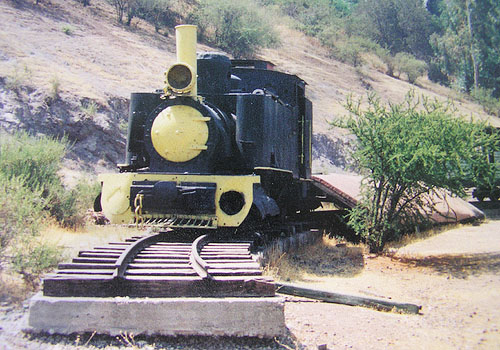
Class 'b' 0-6-0Ts
The Jung/Henschel 0-6-0Ts seem to have become the FCE's Class 'b'. The diagram book labelled them as having been built by Jung. However, three early locos, with marginally smaller side tanks than later engines, were in theory built by Henschel for the Linares to Colbun branch in 1909, though no doubt were distributed as seemed most appropriate when they arrived in the country.
The 1939 and 1952 working timetables list locos numbered 5040-5 as having been built by Jung, and 5056-7 as by Henschel. The third original Henschel seems to have began work at Puente Alto and been transferred with the line to the army, thus never entering EFE lists.
A photo from the Henschel catalogue for 1910, showing one of the three locos bearing a name but no running number as was the DOP's custom (17). Strangely the table of details states inaccurately that these locos were for 762mm gauge, though the branch was 600mm.
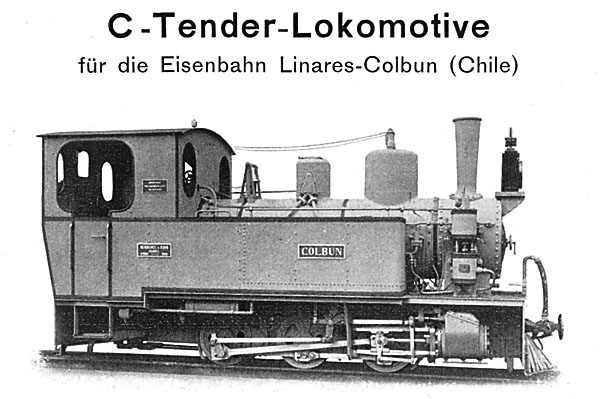
Below is Class 'b' 0-6-0T no. 5044 of the same general pattern but with higher side tanks. It looks as though it has led a somewhat hard life, with the water tank in particular have been patched all along the bottom seam. The photo was provided by Señor Raúl Moroni but the date and location are unknown.
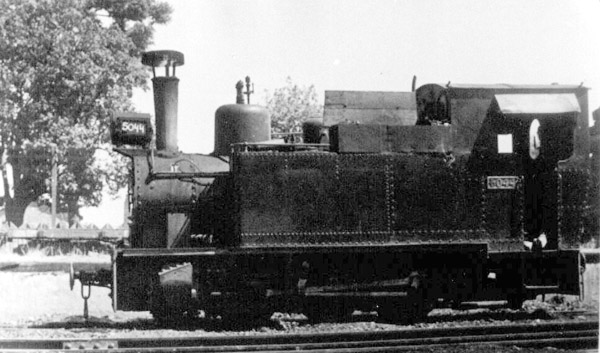
One of these locos, sometimes described as a Henschel, is preserved down on the waterfront in Castro, with the FCE number 5057. This loco was at one time plinthed at the San Bernardo workshops in Santiago. It has been suggested that this is in fact one of the Arnold Jung engines, no. 1857 of 1912. One source (4) states that this locomotive was transferred after closure to the Saboya - Capitan Pastene line on the mainland, running there until its closure in 1970.
5057, pictured in 1993 on the old alignment in Castro, has some detail differences from 5044 above. Apart from the loss of fittings such as headlight, extra bunker boards, and spark arrestor, 5057 seems to have gained a larger sand-dome, though this is not clearly visible in the photo below.
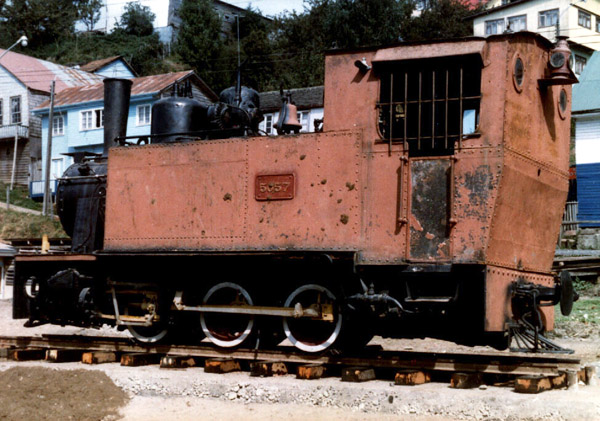
Class 'c' 0-4-0Ts
These are clearly listed in the 1939 and 1952 working timetables as having been built by Jung, however, Carlos Mendez Notari in his Chiloé railway booklet (8) states that there was a 'locomotora de patio', ie a shunting loco, built by 'Hannover Lynden' in 1908. This is presumably from the company 'Hanomag' but no other details are known. The Hanomag list details two 60cm gauge 0-4-0T locos supplied to 'FCP' Chile in 1908 with running numbers 2 and 3. These were Hanomag works numbers 5376-7. There were also small Arnold Jung locos of 1912, which seem to be of the same size. The Jung loco list implies that they were of 50HP.
Class 'd' Davenport 0-6-2Ts originally ordered by the contractors
Whilst all of the other locomotives seem to have been of German origin, there were two American built engines on Chiloé. These were 0-6-2 tank engines built by Davenport of Iowa, USA. Two were ordered by the contractors building the railway, and were completed in July 1909, builders' numbers 894-5. They seem to have been transferred to the operating railway on completion of the construction contract, and appear in a number of early postcards. Driving wheels were 24 inches diameter, cylinders 9" x 14", and weight 20 tons ().
This picture is taken from a Davenport catalogue of about 1923, kindly forwarded by Vance Bass. It will be noted that the loco bears the running number '7', implying that the owners had other earlier locos.
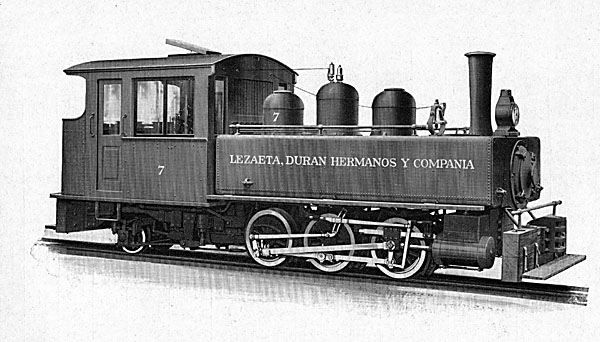
Classes 'f', 'g' and 'h'
The 1939 FCE passenger working timetable ('itinerario') lists one 'f' class, no. 5052 by Henschel; one class 'g', no. 5053 by Henschel; and two of class 'h', nos. 5054 and 5061 by O&K (13). By 1952 the type 'f' had been withdrawn but the remainder were still in service. In addition, a pair of ex WD Hunslet 4-6-0Ts had been purchased second-hand during WW2 and regauged. These were in service in 1952 numbered 5062-3 as type 'b1'.
Smoschewer loco
The Saboya to Capitan Pastene branch possessed at least one 0-6-0 well tank for a while. This is shown in an early drawing displayed on a Flickr page attached to the Capitan Pastene town website. A similar, though not quite identical, loco was stored at Capitan Pastene for a while after closure but is now in the railway museum at the Quinta Normal park in Santiago. Whilst this is often identified as FCE no. 5025 built by SLM in 1945, these details are false. The true identity is more likely to be Smoschewer (a small German manufacturer based in Breslau) number 730 of 1923 (16), and there may have been others from the same builder delivered to Chile. Whether any of them worked in Chiloe is at present unknown.
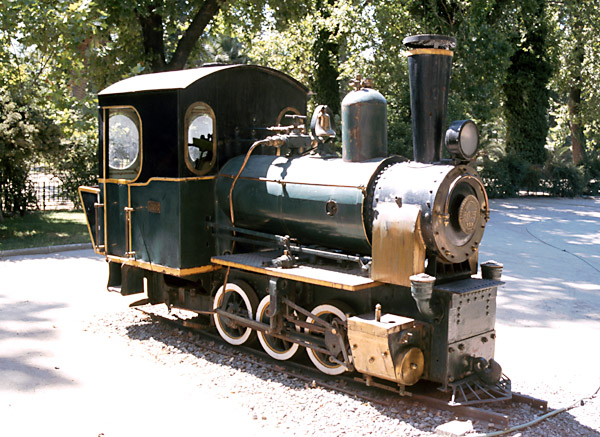
At the time of the official last train rain on Chiloé on 3 March 1959, loco 5060 was used to haul the train. 5039 was to be used for dismantling.
A reminiscence, printed in a book of such recollections by Ancud citizens, says that Ancud 'shed' had three locos, known as 'La Chonchina', 'La Castreña' and 'La 1001' (9).
Loco running numbers
By 1929 all 60cm gauge engines seem to have been numbered in the 5000 series (18). The following table lists all those known, but which lines they each worked on are not yet clear:
Loco number
|
Class
& wheel arrange-ment
|
Maker
number
year
|
Driving wheels
mm.
|
Cyl-inders
mm.
|
Notes
|
5025
|
a
0-6-2T
|
Jung
1350, 1351 or 2034
1909-12
|
0700
|
300 x 350
|
On FCE books in 1939 and 1952. On Chiloé during the 1950s, though at Saboya around 1956 and in poor condition. An undated photo shows high capacity side tanks. However, a smokebox number-plate bearing 5025 is currently displayed on a small 0-6-0T which was stuffed and mounted at Capitan Pastene on the mainland and is now in the Quinta Normal railway museum in Santiago.
|
5038
|
a
0-6-2T
|
Jung
1350, 1351 or 2034
1909-12
|
0700
|
300 x 350
|
On FCE books in 1939 and 1952. At Saboya around 1956 and in fair condition.
|
5039
|
a
0-6-2T
|
Jung
1350, 1351 or 2034
1909-12
|
0700
|
300 x 350
|
On FCE books in 1939 and 1952. On Chiloé with high side tanks in 1951, also present at close of line in 1960. Overturned as a result of a derailment at some date.
|
5040
|
b
0-6-0T
|
Jung
1852-8
1911
|
0624
|
235 x 300
|
On FCE books in 1939 and 1952. Ran on Chiloe at some point.
|
5041
|
b
0-6-0T
|
Jung
1852-8
1911
|
0624
|
235 x 300
|
On FCE books in 1939 and 1952. At Saboya around 1956 but in poor condition.
|
5042
|
b
0-6-0T
|
Jung
1852-8
1911
|
0624
|
235 x 300
|
On FCE books in 1939 and 1952.
|
5043
|
b
0-6-0T
|
Jung
1852-8
1911
|
0624
|
235 x 300
|
On FCE books in 1939 and 1952.
|
5044
|
b
0-6-0T
|
Jung
1852-8
1911
|
0624
|
235 x 300
|
Allocated ('prestada') presumably to Departamento de Vias y Obras in 1929-30 but location unknown (18).On FCE books in 1939 and 1952. At Saboya around 1956 and in fair condition.
|
5045
|
b
0-6-0T
|
Jung
1852-8
1911
|
 |
 |
Allocated ('prestada') to Departamento de Vias y Obras in 1929 & 1931 but location unknown (18). On FCE books in 1939 and 1952. At Saboya around 1956 and in fair condition.
|
5046
|
c
0-4-0T
|
Jung
1859-62
1912
|
0580
|
210 x 300
|
On FCE books in 1939 and 1952.
|
5047
|
c
0-4-0T
|
Jung
1859-62
1912
|
0580
|
210 x 300
|
On FCE books in 1939 and 1952.
|
5048
|
 |
 |
 |
 |
Sold 1929 to Señors Barriga, Wachholtz, and Alessandri y Cia (18), almost certainly for use on this firm's contracts to build the Cocule to Lago Ranco and Corte Alto to Maullin broad gauge branches which began that year.
|
5049
|
 |
 |
 |
 |
 |
5050
|
 |
 |
 |
 |
'Excluidas' from list of operating locos in 1930, 'Desarmada' (dismantled) in 1932 (18).
|
5051
|
 |
 |
 |
 |
'Excluidas' from list of operating locos in 1930 (18). 'Desarmada' (dismantled) in 1932 (18).
|
5052
|
f
|
Henschel?
|
 |
 |
On FCE books in 1939. Allocated ('prestada') to Departamento de Vias y Obras in 1931 but location unknown (18). Loco sold 1941 (18).
|
5053
|
g
|
Henschel, possibly 7493 of 1906
|
 |
 |
Allocated ('prestada') to Departamento de Vias y Obras in 1929 but location unknown (18).'Deveueltas' in 1931. On FCE books in 1939 and 1952.
|
5054
|
h
|
O&K
|
 |
 |
Allocated ('prestada') to Departamento de Vias y Obras in 1929 & 1931 but location unknown (18). On FCE books in 1939 and 1952. At least one of this pair of large O&Ks clearly ran for some years on Chiloe into the 1950s
|
5055
|
c
0-4-0T
|
Jung
1859-62
1912
|
 |
 |
On FCE books in 1939 and 1952.
|
5056
|
b
0-6-0T
|
Henschel
9851-3
1909?
|
 |
 |
On FCE books in 1939 and 1952. At Saboya around 1956 but in poor condition.
|
5057
|
b
0-6-0T,
or class a according to Copeland
|
Henschel
9851-3 (according to 1939 itinerario), or possibly Arn. Jung no. 1857?
|
 |
 |
On FCE books in 1939 and 1952. Transferred to Saboya after closure of Chiloe line. Plinthed first at Maestranza San Bernardo, and now in Castro.Copeland () suggests that 5057 was a class 'a' 0-6-2T, but this is not supported by the working timetables.
|
5058
|
a
0-6-2T
|
Jung 4639-41
1929
|
 |
 |
Purchased 1929 (18). Longer wheelbase. On FCE books in 1939 and 1952.
|
5059
|
a
0-6-2T
|
Jung 4639-41
1929
|
 |
 |
Purchased 1929 (18). Longer wheelbase. On FCE books in 1939 and 1952.
|
5060
|
a
0-6-2T
|
Jung 4639-41
1929
|
 |
 |
Purchased 1929 (18). Longer wheelbase, on FCE books in 1939 and 1952, on Chillan to Recinto branch in 1940, on Chiloé at close of line in 1960.
|
5061
|
h
0-6-2T?
|
O&K
12372
|
 |
 |
Acquired 1932 (18). On FCE books in 1939 and 1952.
|
5062
|
b1
4-6-0T
|
Hunslet
|
 |
 |
British War Department type loco, but completed 1919 to 2' 6" gauge. WD running number 3251 must have been carried for many years as when purchased by EFE it was initially described by this number. Stored at Barnbow Depot, Leeds, England until sold to Beverley Peace & Partners, Antofagasta. Worked on FC Uyuni - Pulacayo, in Bolivia. Acquired by EFE in 1943 via Señor Juan Barceló for $35,000 each and regauged at Maestranza San Bernardo (18). On EFE books in 1953. At Saboya around 1956 and in fair condition.
|
5063
|
b1
4-6-0T
|
Hunslet
|
 |
 |
British War Department type loco, but completed 1919 to 2' 6" gauge. WD running number 3258 must have been carried for many years as when purchased by FCE it was initially described by this number. Stored at Barnbow Depot, Leeds, England until sold to Beverley Peace & Partners, Antofagasta. Worked on FC Uyuni - Pulacayo, in Bolivia. Acquired by FCE in 1943 via Señor Juan Barceló for $35,000 each and regauged at Maestranza San Bernardo (18). On EFE books in 1953.
|
 |
 |
 |
 |
 |
Loco '48' acquired 1933 for 'FC de Coihuaco a Neblinto' (top end of Recinto line), but dismantled later the same year (18).
|
Most data from 1939 itinerario in which 21 of the above 60cm gauge locos were recorded, also the 1952 itinerario. Some extra detail from FCE annual Memoria reports.
|
The difficulty is to match the running numbers in the above list with builders' numbers. The following table lists all known 60cm gauge steam locos delivered to Chile. Not all of them will have been for the FCE lines, some being for industrial use elsewhere. It will be obvious that there is a shortfall already, and if the missing running numbers in the table above were used at some point, then a further large number of unknown locos must have arrived in Chile over the years.
60cm gauge steam locomotives delivered to Chile
not necessarily all for the FCE branches.
|
Maker
number
year
|
Wheel arrange-ment
|
Dimensions
|
Weight
|
 |
Notes
|
Krauss
4685
1901
|
0-6-0 (Cn2t)
|
 |
 |
 |
Arthur Koppel for Chile
|
Krauss
4840
1903
|
0-4-0 (Bn2t)
|
 |
 |
 |
Arthur Koppel for Chile
|
O&K
1187-8
1904
|
0-4-0T
(Bt)
|
 |
 |
50HP
|
Mines de Cuivre de Magallanes via Punta Arenas, Chile. (Cutter Cove). (75cm gauge)
|
O&K
1754
1906
|
0-6-0T
Ct
|
 |
 |
30HP
|
Poepke & Luer, Chile
|
Henschel
7493
1906
|
0-4-0T
|
 |
 |
 |
via Gebr. Vorwerk & Co., Hamburg. Copeland says this went to Chile, but Merte's list gives no customer name. Vorwerk certainly acted as Henschel agents in Chile for some years, bidding for DOP contracts.
|
Hanomag
4848-9
1907
|
0-4-0
|
 |
 |
 |
via Koppel, for Chile
|
O&K
2850
1907
|
0-8-0T
Dt
|
 |
 |
110HP
|
Chile, possibly for the army
|
Jung
1188
1907
|
0-4-0T
|
 |
6.45 tonnes
|
30hp
|
Arthur Koppel, Berlin, for Chile
|
Jung
1191-3
1907
|
0-6-0T
|
 |
5.2 tonnes
|
20hp
|
Arthur Koppel, Berlin, for Chile. 1192 'Fresia' worked at Mina Pilpilco.
|
Jung
1199-1200
1907
|
0-6-0T
|
 |
7.6 tonnes
|
50hp
|
Copeland lists these as 600mm gauge but Merte's list says 762mm.
|
Jung
1215
1907
|
0-4-0T
|
 |
5.36 tonnes
|
30hp
|
Arthur Koppel, Berlin, for Chile
|
Hanomag
5158
1908
|
0-4-0T
|
 |
 |
 |
via Schobach, Hamburg, for Chile, named 'Graciela'.
|
Hanomag
5376-7
1908
|
0-4-0T
|
 |
 |
 |
For 'FCP' with numbers 2 and 3. Might FCP be a misreading of DOP?
|
Henschel
9851-3
1909
|
0-6-0T
|
 |
 |
 |
Built for Linares-Colbun branch which is 600mm, though 1910 Henschel catalogue strangely shows these locos as 750mm. Henschel list says 600mm however.
|
Davenport
894-5
1909
|
0-6-2T
|
24" wheels, cyls. 9" x 14"
|
20 tons
|
 |
Ordered by Lezaeta, Duran Hermanos y Cia for construction of Ancud-Castro line and then bought by DOP for use on the completed line and transferrrd to FCE.
|
Bagnall
1914
1910
|
0-4-0ST
|
 |
 |
 |
For Oficina Franca, abandoned 1927. Numbered 'DIECIOCHO'. Preserved SOQUIMICH Pedro de Valdivia.
|
Jung
1296
1910
|
0-4-0T
|
 |
 |
30hp Hebel
|
O&K Berlin for Chile
|
Jung
1306-7, 1350-1
1909
|
0-6-2T
|
 |
 |
 |
According to Jens Merte's Jung list these locos went to the Otavi Railway in German South West Africa, but they received no more Jung 0-6-2Ts after 1904. The preserved loco from the Puente Alto to El Volcan line carries some parts stamped 1307.
|
Jung
1517
1910
|
0-4-0T
|
 |
 |
20hp
|
O&K Berlin for Chile
|
Jung
1518
1910
|
0-6-0T
|
 |
 |
70hp
|
M. Gildemeister, Bremen, for Chile
|
O&K
3962-3
1910
|
0-4-0T
(Bt)
|
 |
 |
50hp
|
Saavedra Benard & Co, Valparaiso.
|
O&K
3992
1910
|
0-6-0T
|
 |
 |
40hp
|
via Saavedra Benard, Valparaiso, for Ancud Castro
|
O&K
4248
1910
|
0-4-0T
(Bt)
|
 |
 |
20hp
|
Stumpfoll Hermanos, Osorno, Chile (Sawmill and timber works)
|
O&K
4902
1911
|
0-4-0T
Bt
|
 |
 |
10HP
|
S.B. & Co (Saavedra Benard?) Valparaiso, Chile
570mm gauge.
|
O&K
4916
1911
|
0-6-0T
Ct
|
 |
 |
30HP
|
Moro & Lukinovic. Iquique, Chile.
|
O&K
5144
1911
|
0-4-0T
(Bt)
|
 |
 |
20hp
|
Eduardo Charone, Santiago.
|
O&K
5711-2
1912
|
0-4-0T
(Bt)
|
 |
 |
30hp
|
Entreprise du Port de San Antonia Haag, Chile
|
O&K
5815
1912
|
0-6-0T
|
 |
 |
90hp
|
via Saavedra Benard, Valparaiso, for Ancud Castro
|
Jung
1852-8
1912
|
0-6-0T
|
 |
13 tonnes
|
 |
Chilenische Staatsbahn
|
Jung
1859-62
|
0-4-0T
|
580mm wheels
210x300 cyls.
|
9.3 tonnes
|
50hp?
|
Chilenische Staatsbahn
|
Jung
2034
1913
|
0-6-2T
|
 |
17 tonnes
|
150hp
|
Chilenische Staatsbahn
|
O&K
6147
1913
|
0-6-0T
Ct
|
 |
 |
20HP
|
Cia. de Salitreras de Antofagasta, Chile
|
O&K
6186-6191
1914
|
0-8-0T
(Dt)
|
 |
 |
80hp
|
Chilenische Militäreisenbahn, nos. 1-6. ie for Puente Alto - El Volcan. The suspicion must be that the army, finding that the DOP had left it rather inadequate motive power to work the line, and not being as financially constrained as other parts of the government, decided in the way of all armies that it needed to do the job properly and promptly ordered six 0-8-0Ts.
|
O&K
6286
1913
|
0-6-0T
(Ct)
|
 |
 |
50hp
|
Ramon J. Nieto, Chile, 'Pontevedra'.
|
O&K
6292
1912
|
0-4-0T
(Bt)
|
 |
 |
20hp
|
Saavadra Benard & Co, Valparaiso for Coronel, Chile.
|
O&K
6518
1913
|
0-6-2T
(C1t)
|
 |
 |
125hp
|
Dirreccion General de Obras Publicas, Santiago
|
O&K
6628-9, 32-3
1913
|
0-4-0T
(Bt)
|
 |
 |
50hp
|
Entreprise du Port de San Antonio, Chile
|
O&K
6648-50
1913
|
0-4-0T
(Bt)
|
 |
 |
30hp
|
Louis Lagarrigue & Co., Chile.
|
O&K
6728
1913
|
0-6-0T
(Ct)
|
 |
 |
30hp
|
Enrique Döll, Chile
|
O&K
6819
1914
|
0-4-0T
Bt
|
 |
 |
 |
Louis Lagarrigue & Co., Chile.
|
O&K
6831
1913
|
0-4-0T
Bt
|
 |
 |
 |
Louis Lagarrigue & Co., Santiago, Chile.
|
O&K
6988-9
1914
|
0-6-0T
(Ct)
|
 |
 |
 |
Gildemeister & Co., Valparaiso, for Tocopilla, Chile.
|
O&K
7120
1914
|
0-6-?T
(3/4t)
|
 |
 |
125hp
|
via Saavedra Benard, Valparaiso, for Ancud Castro. An order for two more 0-6-2Ts in 1912 was spilt between Jung and O&K. This loco, and the later O&K 12372, were therefore O&K's attempt to build to the 'tipo a' specification.
|
Henschel
13077-8
1914
|
0-4-0 Bn2t
|
 |
 |
 |
Lagarrigue, Santiago de Chile
|
Hanomag
9231-2
1920
|
0-4-0T
|
 |
 |
 |
via Sloman & Co., Hamburg, for Chile
|
O&K
7489-90
1920
|
0-6-0T
(Ct)
|
 |
 |
 |
Comunidad Quellon, Valparaiso. ie the Quellon distillery.
|
O&K
7627
1920
|
0-6-0T
(Ct)
|
 |
 |
 |
Gildemeister & Co., for Valparaiso.
|
O&K
9317
1920
|
0-6-0T
(Ct)
|
 |
 |
 |
Gildemeister & Co., Valparaiso.
|
O&K
9436
1920
|
0-6-0T
(Ct)
|
 |
 |
 |
Gildemeister & Co., Valparaiso.
|
 |
0-6-2T
|
 |
 |
 |
FCE list of 60cm gauge locos in 1960 includes three class 'a' locos built in 1922. However, this is almost certainly wrong.
|
O&K
10191
1923
|
0-4-0T
(Bt)
|
 |
 |
50hp
|
Louis Lagarrigue & Co., Santiago, Chile.
|
Smoschewer
730
1923
|
0-6-0WT
|
 |
 |
 |
 |
O&K
10858
1924
|
0-6-0T
(Ct)
|
 |
 |
 |
O&K lager (ie for stock), Valparaiso.
|
Jung
3503
1925
|
0-6-0T
|
 |
 |
 |
H. Folsch, Hamburg, for Chile , for Nitrate works in northern Chile
|
O&K
11350
1927
|
0-6-6-0T
(CCt)
|
 |
 |
 |
Militär de Puente Alto - El Volcan, Chile. This was the FC del Cajon de Maipo's only articulated loco.
|
O&K
11483
1927
|
0-4-0T
Bt
|
 |
 |
50HP
|
H. Möller, Hamburg Chilehaus (Händler)
|
Maffei
4336-7
1928
|
0-4-0T
|
 |
 |
 |
Ferrostaal GMBH, Essen, for Chile.
|
Maffei
4341-4
1928
|
0-6-0T
|
 |
 |
 |
Ferrostaal GMBH, Essen, for Chile. Possibly purchased for the Las Raices tunnel project.
Both now preserved. 4336 seen by Wilfred Simms plinthed at Taller San Eugenio.
|
Jung
4639-41
1929
|
0-6-2T
|
 |
19 tonnes
|
 |
Fölsch & Co, Hamburg for Chile. FCE 5058-60.
|
O&K
12372
1931
|
0-6-2T
(C1t)
|
 |
 |
 |
FC del Estado, Santiago, Chile. Must be FCE 5061.
|
O&K
12686
1935
|
0-6-0T
Ct
|
 |
 |
 |
Comunidad Quellon, Chile, ie. the Quellon distillery
|
O&K
12855
1936
|
0-4-0T
Bt
|
 |
 |
 |
Dep de Riego in Valenzuela, Santiago, Chile. Worked at Mina Lota? (preserved in Lota?)
|
O&K
13306-8
1944
|
0-6-6-0T
(CCt)
|
 |
 |
250hp
|
FC Militär Puente Alto - El Volcan, but owing to war conditions delivered to Poland instead.
|
 |
 |
 |
 |
 |
 |
Photos of individually identifiable locos at work are very few and far between. The picture below shows class 'a' no. 5025, supposedly at Castro loco shed during the 1950s (14). There appears to be a turntable in the background.
References:
1 El Tren de Chiloé. 1986. Gustavo Boldrini P. Centro de Folklore Magisterio Ancud. Page 39, quoting from La Cruz del Sur, Ancud, 7th June 1911.
2 As above.
3 O. & K. Dampflokomotiven - Lieferverzeichnis 1892-1945 (A list of all O. & K. steam locos with their initial destinations) by R. Bude, K. Fricke & Dr. M. Murray, 1978. Railroadiana Verlag.
4 The Railways of Chile, Volume 5 - Southern Chile. 2002. Wilfred Simms.
5 O. & K. Dampflokomotiven - Lieferverzeichnis 1892-1945 (A list of all O. & K. steam locos with their initial destinations) by R. Bude, K. Fricke & Dr. M. Murray, 1978. Railroadiana Verlag.
6 Mito, Historia y Leyendas del Tren Chilote. 1996. Carlos Mendez Notari. Page 24
7 Railways of South America: Part 3: Chile. 1930 (W. Rodney Long , U.S. Bureau of Foreign and Domestic Commerce - Trade Promotion Series No. 32, U.S. Government Printing Office, Washington D.C.
8 As above, page 22
9 Ancud - Testimonio de un siglo que se fue. 1999. Radio Estrella del Mar. page 129.
10 Photo from Brattstrom collection in library of Centro Cultural, Castro.
11 El Tren de Chiloé. As above, page 42, quoting from La Cruz del Sur, Ancud, 7th June 1911.
12 El Tren de Chiloé. As above, page 39, quoting from La Cruz del Sur, Ancud, 9th November 1912.
13 Itinerarios, Red Sur, 43a Edicion, 1939, FFCCdelE, Santiago.
14 Photo from the collection of Señor Luis Mardones Ballesteros kindly forwarded by Señor Luis Alberto Mancilla.
15 Una nueva perspectiva de la historia del Ferrocarril Militar del Cajón del Maipo. Ian Thompson Newman, 2005. Available in digital form on the <www.monumentos.cl> website.
16 Personal communications from Dr. Martin Murray and Richard Bowen, 2009.
17 Scan from the 1910 Henschel catalogue kindly provided by Señor Daniel Caso.
29-4-13
|
|
